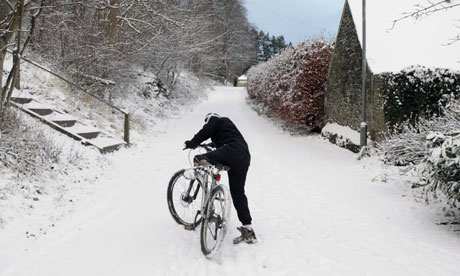By J. DAVID GOODMAN

Pascal Sauvayre hopped his front tire through several inches of freshly fallen powder, stopping in front of a small group of cyclists gathered in the morning darkness at the southeast end of Central Park.
“Pascal! Oh, he’s a hardy soul,” called out one of the assembled, Dave Jordan, a pair of ski goggles hanging around his black neck gaiter and a headlamp shining from his helmet.
“I had to shovel the sidewalk anyway,” Mr. Sauvayre said, explaining why he had come out, at 6:30 on a frigid morning this month, for this race in the snow that had been hastily arranged online days before. It would be fun, the 50-year-old psychologist said.
“This is legit powder!” another rider called out. “Let’s go!” said another. And the group began slowly rolling into the deserted white park.
Such high spirits notwithstanding, riding in the dead of winter, in several inches of snow, is not everyone’s idea of a good time. The cold pushes many cyclists indoors, and the snow often deters the rest. Commuting rates drop precipitously, and bike lanes can be empty for long stretches of time.
But there are also those determined, or required, to stay in the saddle all year round, and they greet the cold by reaching for an extra breathable layer, a balaclava and some booties.
“Today, I couldn’t even feel my toes when I got to work,” said Meena Kim, 31, a fashion designer who lives in Williamsburg, Brooklyn, and rides to work on West 14th Street. Bike fenders, more than warm clothing, are key to surviving wet winter conditions, she said. “If you don’t have a fender, you get super slush butt.”
Even in winter, Ms. Kim said, the bike is the best way for her to get around from band practice to various aspects of her social life. “It can be slushy and disgusting, but it’s totally ridable and it’s so worth it,” she said.
The snow also changes the topography of the city, narrowing streets and disrupting the flow of cars and pedestrians. “When it gets gnarly out there like this, every 10 feet you’re reassessing the situation,” said Ethan Benton, 34, who works at home in Bedford-Stuyvesant, Brooklyn, but uses his bike as his primary mode of transportation.
Most sidewalks are cleared by tossing snow into the street, and cars can reduce the flakes to slush and dirty water. That often sends cyclists from hugging the sidewalk into the drier center lanes, which can be dangerous.
“You definitely fall a lot more in the winter,” said Jessica Meany, 24, of Williamsburg. “But at the same time, you have so much gear on, you don’t have to worry about bad scrapes.”
Some riders adopt the time-tested tricks of messengers, food deliverers and others who must ride in the snow, including carrying an extra wool layer, wearing a good pair of all-weather construction gloves or wrapping the seat and handle bars — and even the feet and hands — in plastic.
All that might not sound like fun. But the payoff, Ms. Meany said, is that the hardy band of winter riders often have the roads and bike paths to themselves. “We wave to each other — it’s pretty funny,” she said of her interactions with riders on the Williamsburg Bridge. “That never happens in the summer.”
Read the full article here.
 The economy was weak, the job market grim and the political outlook more than a little challenging, but the
The economy was weak, the job market grim and the political outlook more than a little challenging, but the 

